#philopator
Explore tagged Tumblr posts
Photo
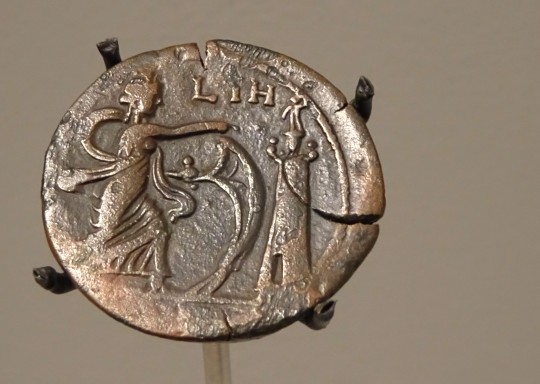
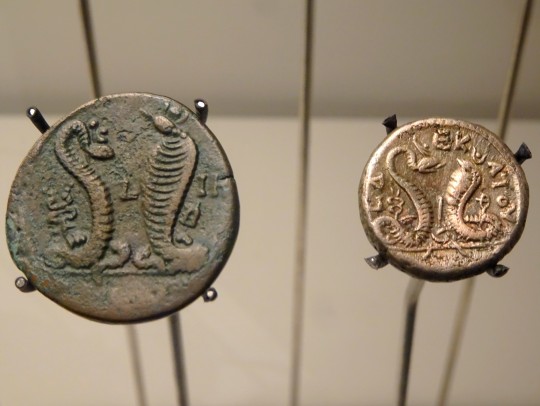
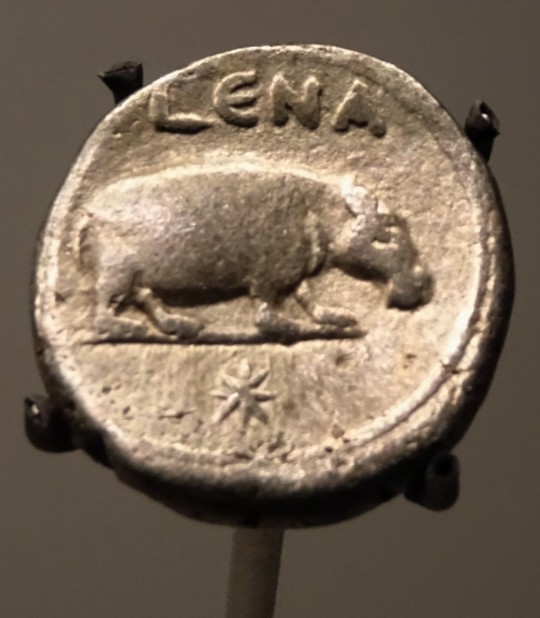

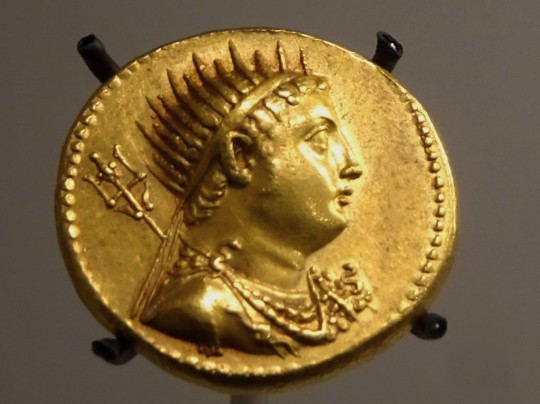
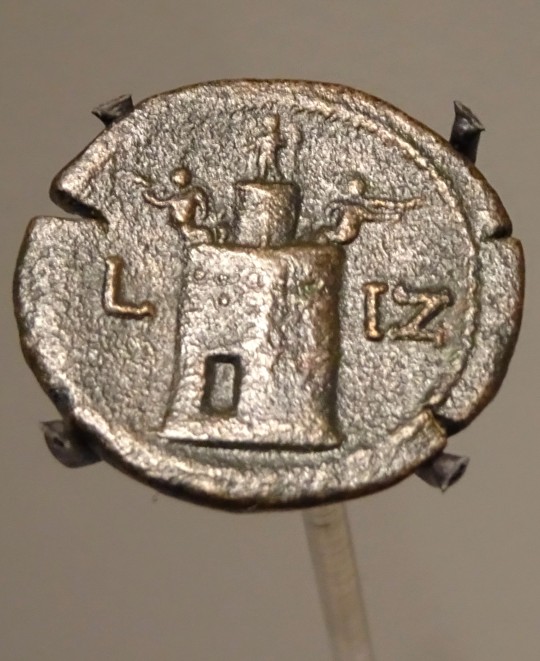
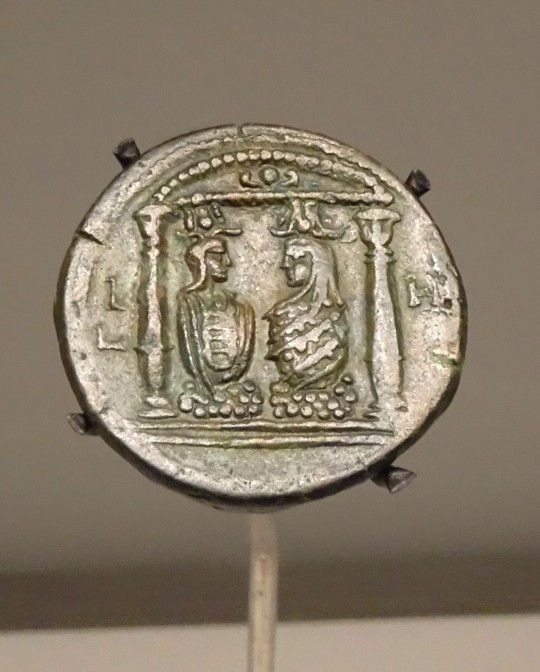
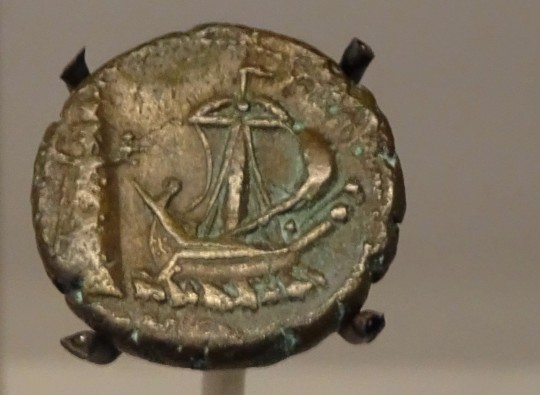
Marseille. Au MuCEM, il y a une expo : “Alexandrie, Futurs Antérieurs”:
- monnaie d'Hadrien, Isis à la voile devant le phare - 2ème s. apr. J-C.
- monnaies d'Hadrien - période gréco-romaine
- monnaie de Néron, hippopotame - période gréco-romaine
- monnaie d'Octave-Auguste, crocodile avec légende “Aegypto capta" - période gréco-romaine
- monnaie de Ptolémée IV Philopator - période gréco-romaine
- monnaie d'Hadrien, le Phare d'Alexandrie, bronze - 2ème s. apr. J-C.
- monnaie d'Hadrien, temple et 2 divinités, bronze - 2ème s. apr. J-C.
- Monnaie de Commode, le Phare et un navire - 2ème s. av. J-C.
#marseille#MuCEM#expo#alexandrie#alexandrie futurs antérieurs#phare d'alexandrie#phare#numismatique#archéologie#égypte antique#égypte romaine#hadrien#néron#octave-auguste#ptolémée#ptolémée V#philopator#ptolémée V philopator#commode#empereur#empereur romain#hippopotame#crocodile#aegypto capta#isis
2 notes
·
View notes
Text
A black bassalt statue of Cleopatra VII Philopator, the last Hellenistic queen of Egypt, as Isis-Aphrodite

State Hermitage Museum, Saint Petersburg. ДВ-3936
Source of the picture: https://egypt-museum.com/statue-of-cleopatra-vii-philopator/
See also on this statue https://www.worldhistory.org/image/8294/cleopatra-as-isis-aphrodite/
382 notes
·
View notes
Text
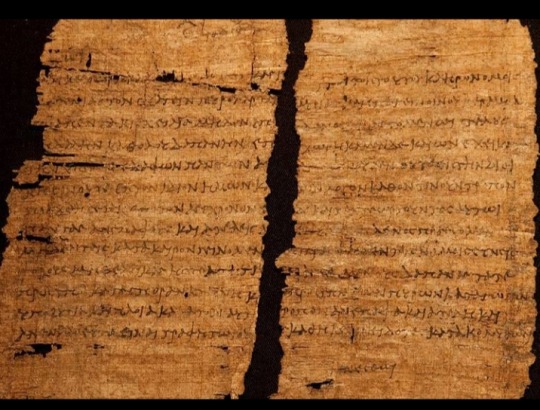
This papyrus signed by Cleopatra grants tax exemption from sales of imported wine to the Roman businessman Publius Canidius, a friend of Mark Antony.
At the bottom, in a rare example of her handwriting, Cleopatra herself added the Greek word "ginesthoi," which means "make it happen."
—
Cleopatra VII Thea Philopator (70/69 BC – 10 August 30 BC) was Queen of the Ptolemaic Kingdom of Egypt from 51 to 30 BC, and its last active ruler.
#Cleopatra#Mark Antony#Publius Canidius#Cleopatra VII Thea Philopator#Ptolemaic Kingdom#Egypt#Ancient Egypt
666 notes
·
View notes
Text

68 notes
·
View notes
Text

#acorigins#assassin's creed#assassin's creedassassin's creed origins#ubisoft#virtual photography#photomode#gaming photography#video games#vgedit#cleopatra#Cleopatra VII Thea Philopator#**acorigins#**#camera tools
7 notes
·
View notes
Text
Philip Evelyn and Caleb animatic to Copacabana. Is this doing anything for anyone
#Lola and Tony are Caleb and evelyn#Philip is Rico#I think first verse Caleb would be Lola but second verse he’d be Tony#And the last verse would be about philip#Losing his marbles while making the grimwalkers#The owl house#philop wittebane#Evelyn clawthrone#Caleb wittebane
5 notes
·
View notes
Text
My favorite Cleopatra in Space Character is Cleopatra Philopator VII!
The Space Princess of Egypt!








#dreamworks#dreamworks animation#cleopatra in space#cleopatra philopator vii#cleopatra#cleo#cleopatra philopator
2 notes
·
View notes
Text
tags masterpost
#for you i’d bleed myself dry — waldeamar#the witness of life — faceclaim#they are the hunters we are the foxes — ex camarilla#you’ve got blue blood on your hands — primogen era#i see no angels here — LA era#the call of the varangians — Kievan Rus’ era#land of the sunset — Morocco era#a mithqal of saffron — Mali Empire#the slowly freezing heart — Philopator bloodline#general (an)aesthetic#i can’t believe that you don’t hear me; but you will eventually — Black Agnes#taste like codeine drippin on me — anna sokolova
0 notes
Text
The Temple of Dendera Egypt
Pondering the Ceiling at Dendera Temple Yesterday I visited Dendera – the Temple of Hathor, a one-hour drive from Luxor. Dendera lies along the Nile River near the small Egyptian town of Dendera. The temple was “inhabited in prehistory as an oasis on the west bank of the Nile, south of Qena”. The complex was less crowded than the tours I’ve taken in Luxor. Aerial View Dendera Temple – Viator It’s…
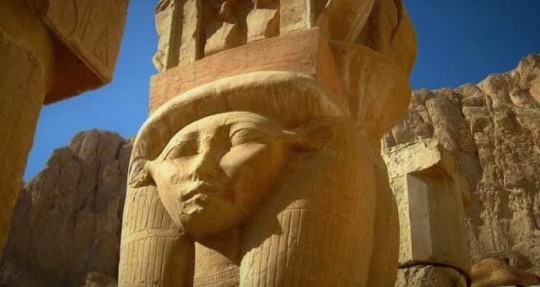
View On WordPress
#Astronomical Ceiling Hypostyle Hall Dendera#Bedouins#Birthing Temple#Chapel of Osiris Dendera#Cleopatra VII Philopator#Coptic Christian Church#Dendera Crypt#Dendera Great Vestibule#Dendera Lightbulb#Dendera Temple#Dendera Underground Crypt#Dendera Zodiac#Egyptian and Greco-Roman Period Rulers#Egyptian Goddess Hathor#Egyptian Hieroglyphs#Egyptian pharaohs. Temple of the Goddess Isis#Eye of Horus#God Bes#Hathor Egyptian Sky Goddess#Ihy Son of Horus#Isis#Luxor Egypt#Main Dendera Temple Dedicated to Hathor Egyptian Sky Goddess#Nut (Nuit) Egyptian Sky Goddess#Osiris#Ptolemy XII – Macedonian King of Egypt#Ptolemy XV Philopator Philometor Caesar (Caesarion)#Queen Cleopatra VII. Queen Cleopatra#Sanctuary of Hathor#Sanctuary of Horus
1 note
·
View note
Text

On September 2nd, in 44 B.C. Cleopatra VII named her then three year old son by Caesar the King of Egypt and her co ruler. After Caesar’s murder on the infamous “Ides of March”, the Egyptian Royal Family had fled from Rome for their safety and returned home to Alexandria. Pregnant with their second child at the time of Caesar’s death, Cleopatra miscarried the child sometime during the flight or shortly after.
Her half brother/husband, Ptolemy XIV, died sometime after July 26, 44 BC, which is the date of the last known inscription that mentions him being alive. He would have been about 17 at the time, and of an age to take an active role in ruling, which is something Cleopatra wouldn’t have wanted. It is often thought, though un-proven, that she had the young Ptolemy killed so she could replace him on the throne with her son and Caesar’s only living biological child.
The new King was officially known as Ptolemy XV Philopator Philometor Caesar, with an additional set of Egyptian Names, though he most often went by the nickname of Caesarion. Because of his young age at the time, he was King in name only and his mother kept all real authority to herself
#cleopatra#cleopatra vii#caesarion#ancient egypt#ptolemaic dynasty#caesar#julius caesar#long live the queue
84 notes
·
View notes
Text
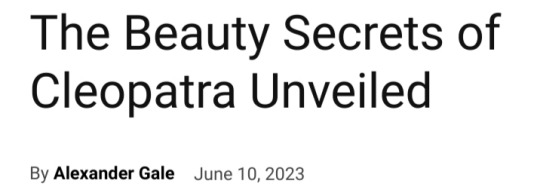

A significant part of Cleopatra VII Philopator’s enduring reputation is as one of history’s most famous femme fatales, renowned for her beauty and wit which attracted not one, but two of the Roman Republic’s most powerful men.
Whether or not this popular characterization of Cleopatra is historically accurate, her reputation has led many to wonder whether she had any particular beauty secrets that she used to ensure Julius Caesar and Mark Anthony.
The historical record does provide some clues as to how the Ptolemaic dynasty’s most famous ruler presented herself, from hairstyles to clothing, and even makeup.
Although we cannot be entirely certain how she presented herself, there are enough historical details to piece together a reasonable picture of how Cleopatra might have presented herself.
Was Cleopatra really a beauty?
As the old adage goes, “Beauty is in the eye of the beholder.”
As far as the ancient sources are concerned, the question of Cleopatra’s beauty raised mixed responses, with some ascribing an irresistible physical appearance to her and others attributing her allure more to her intellect and charm.
For example, Cassius Dio (164 to c. 235 AD), an ancient Greek historian, described Cleopatra as “a woman of surpassing beauty.”
During the first meeting between Julius Caesar and Cleopatra, Cassius Dio wrote:
"Caesar, upon seeing her and hearing her speak a few words, was so completely captivated that the Roman general acquiesced immediately to Cleopatra’s requests."

Plutarch (c.46 to c.119 AD) also briefly commented on the Ptolemaic queen’s appearance in his Life of Mark Anthony.
Contrary to Cassius Dio, Plutarch did not reckon Cleopatra’s beauty to be particularly noteworthy but instead praised her intelligence and character.
“Her beauty, so we are told, was not itself outstanding; it did not immediately strike those who saw her; yet being with her had an inescapable hold; when talking with her, she was persuasive, and the character which surrounded her whole manner in company had a force to it,” wrote the Greek historian and philosopher.
Hair and makeup
In the few surviving marble busts of Cleopatra, she is depicted wearing her hair tied at the back in a bun.
Historians like Paul Edmund Stanwick refer to this as a “melon hairstyle.”
Coinage depicting the queen shows her wearing the same hairstyle.
Depictions of Cleopatra with this hairstyle also show her wearing a diadem, a symbol of royal power adopted by many Hellenistic rulers who succeeded Alexander the Great as the masters of the divided fragments of his empire.

Professor Diana Kleiner of Yale University has identified two more hairstyles worn by Cleopatra.
One of these hairstyles emulated those worn by Macedonian queens, which is unsurprising given Cleopatra’s lineage.
To achieve this style, the hair was carefully divided into individual curls, which were typically swept away from the face and elegantly gathered into a bun positioned at the back.
According to Professor Keline, it may have been worn during travel.
The other hairstyle was “the usual Egyptian wigged headdress that had its origins in Pharaonic times.”
In this case, the main point of attention would have been the headdress rather than the hair itself, with a rearing cobra made of precious metal proudly displayed.
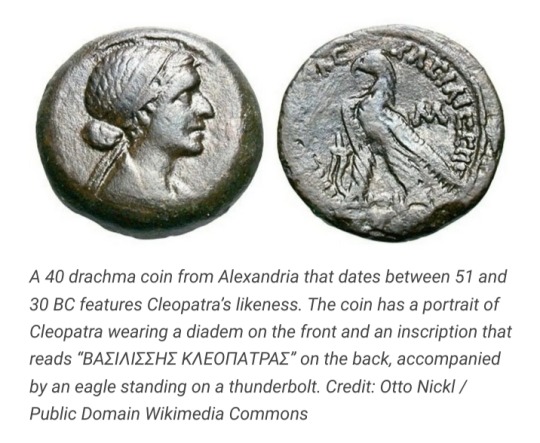
Professor Kleiner explains that “Cleopatra appears to have worn different coiffures in different circumstances, playing to her audience, so to speak, in life and in art.”
It would have been important for her to present herself in the Hellenistic fashion to the Greek elites who held the most senior positions in Ptolemaic Egypt, but also in traditional Egyptian fashions for her ruler to appear legitimate to a native Egyptian audience.
Regarding the Ptolemaic queen’s makeup choices, she would darken her eyebrows and enhance her eyeliner using black kohl, creating an elongated look.
The application of deep blue eyeshadow extended gracefully up to her brows, further accentuating her eyes.
Additionally, Cleopatra embraced the fashionable trend of adorning her hands with intricate henna patterns, a popular practice during that era in Alexandria.
Clothing
Cleopatra wore a variety of Greek, Egyptian, and Roman outfits intended to accentuate her beauty.
The selection of these styles would have been dependent on the contexts in which the queen appeared, as it was important for her to present herself accordingly to her friends, foes and subjects.
One of the styles she wore combined Greek and Egyptian aesthetic sensibilities and is seen depicted on sculptures of other Ptolemaic queens.
This style consisted of a sheer dress, likely of a semi-transparent material, which left the bare breasts exposed in a manner popular amongst native Egyptian women.
The depictions of other Ptolemaic queens wearing this style are consistent with the writings of the Roman poet Lucan, who claimed that she wore a transparent dress that exposed her breasts, likely made of Chinese silk.
Lucan also described the jewelry she wore, writing that “her baleful beauty inordinately painted, covered with Red Sea pearls, a fortune in her hair and around her neck, weighed down with jewelry.”
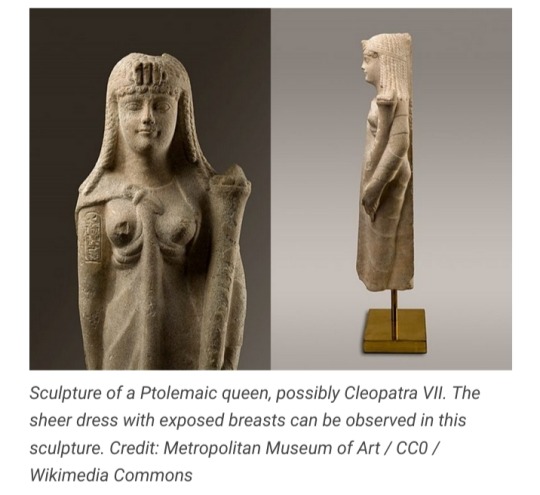
NOTE:
Cleopatra VII Thea Philopator (70/69 BC – 10 August 30 BC) was Queen of the Ptolemaic Kingdom of Egypt from 51 to 30 BC and its last active ruler.
A member of the Ptolemaic dynasty, she was a descendant of its founder, Ptolemy I Soter, a Macedonian Greek general and companion of Alexander the Great.
#Cleopatra VII Thea Philopator#Cleopatra#Queen of the Ptolemaic Kingdom of Egypt#Ptolemaic Dynasty#Ancient Egypt#Ptolemy I Soter#Ancient Macedonians#Julius Caesar#Mark Anthony#Cassius Dio#Plutarch#melon hairstyle#Egyptian fashion#Lucan#Ptolemaic Queen#Hellenistic fashion#Alexandria#Beauty Secrets of Cleopatra
53 notes
·
View notes
Photo

Cleopatra & Antony
Regarded by the Romans as "fatale monstrum" – a fatal omen – Cleopatra is one of the ancient world's most popular, though elusive figures. The Egyptian queen has been immortalized by numerous writers and filmmakers, most popularly by William Shakespeare in Antony and Cleopatra, and by Hollywood in Cleopatra (1963), starring Elizabeth Taylor and Richard Burton. The latter work features the memorable image of the enticing young Cleopatra emerging gracefully from an unfurled carpet in front of Roman general Julius Caesar. But is Cleopatra to be regarded merely as the lover of Julius Caesar and Mark Antony? Or did she play an important role not only in the history of Egypt but also in that of the mighty Roman Republic?
Cleopatra VII Philopator ('father-loving') was born in January 69 BCE in the city of Alexandria, Egypt, the daughter of Ptolemy XII Auletes (117-51 BCE) and possibly Cleopatra V Tryphaena (c. 95 to c. 57 BCE). Cleopatra was to become the last monarch of the Ptolemaic Dynasty (established in 323 BCE after the death of Alexander the Great), ruling Egypt from 51 BCE to 30 BCE. In 48 BCE, Cleopatra had become an ally and lover of Julius Caesar and remained so until his assassination in Rome in March 44 BCE. The assassination of Julius Caesar threw Rome into turmoil, with various factions competing for control, the most important of these being the armies of Mark Antony (83-30 BCE) and Octavian (63 BCE to 14 CE), the former a supporter and loyal friend Caesar, the latter his adopted son.
Cleopatra Meets Antony
In 41 BCE, Cleopatra was summoned to Tarsus (in modern southern Turkey) by Mark Antony. She is said to have entered the city by sailing up the Cydnus River in a decorated barge with purple sails, while dressed in the robes of the Greek goddess Aphrodite. Antony, who equated himself with Dionysus, the god of wine in Greek mythology, was instantly won over. Much like the meeting between Cleopatra and Caesar, both sides saw something in the other that they needed. For Cleopatra, it was another opportunity to achieve power both in Egypt and in Rome; for Antony, the support of Rome's largest and wealthiest client states in his campaign against the might of the Parthians (Parthia was a region in modern north-eastern Iran) was highly desirable. At the meeting, Cleopatra allegedly requested that her half-sister Arsinoë, living in protection at the Temple of Artemis at Ephesus, be executed to prevent any future attempts on her throne. Antony and Cleopatra soon became allies and lovers, and he returned with her to Alexandria in 40 BCE.
In Alexandria, Cleopatra and Antony formed a society of "inimitable livers", which some historians have interpreted as an excuse to lead a life of debauchery, though it was more likely to have been a group dedicated to the cult of the mystical god Dionysus. In that year, Cleopatra bore Antony the twins Alexander Helios (the Sun) and Cleopatra Selene II (the Moon).
Continue reading...
52 notes
·
View notes
Text
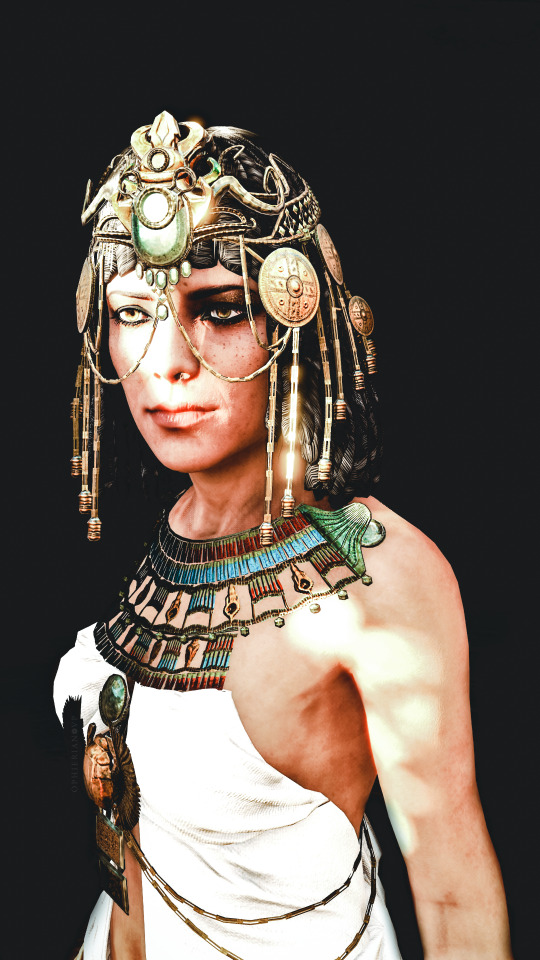
#assassin's creed origins#gamingedit#acorigins#assassin's creed#assassin's creedassassin's creed origins#ubisoft#virtual photography#photomode#gaming photography#video games#vgedit#cleopatra#Cleopatra VII Thea Philopator#**acorigins#**#in game photography#camera tools
6 notes
·
View notes
Text

Statue of Queen Cleopatra
Black basalt statue of Cleopatra VII Philopator, last active ruler of the Ptolemaic Kingdom of Egypt, 1st century BC.
Cleopatra VII Philopator is one of the most mesmerizing women in all of history. Born of a Ptolemy, she became queen at the early age of 17. She was highly educated in the full laws and customs of Egypt, Greece, and Rome, she engrossed herself in science, philosophy, women’s issues, and most impressive the native language of Egypt. She chose to link herself with Egypt by her dress, worship, and representation.
Now in the State Hermitage Museum, Saint Petersburg. ДВ-3936
Read more
369 notes
·
View notes
Text
“i’m confused are you Cleopatra VII or Cleopatra VIII” i’m actually both. i am the reincarnation of Cleopatra VII Thea Philopator Ptolemy but in this reincarnated form i am known as Cleopatra VIII heiress of Alexander heiress of Zeus conqueror of rome faithful of olympus mother of the nile milk-giver of humanity rightful empress of the world. hope this helps💕
30 notes
·
View notes
